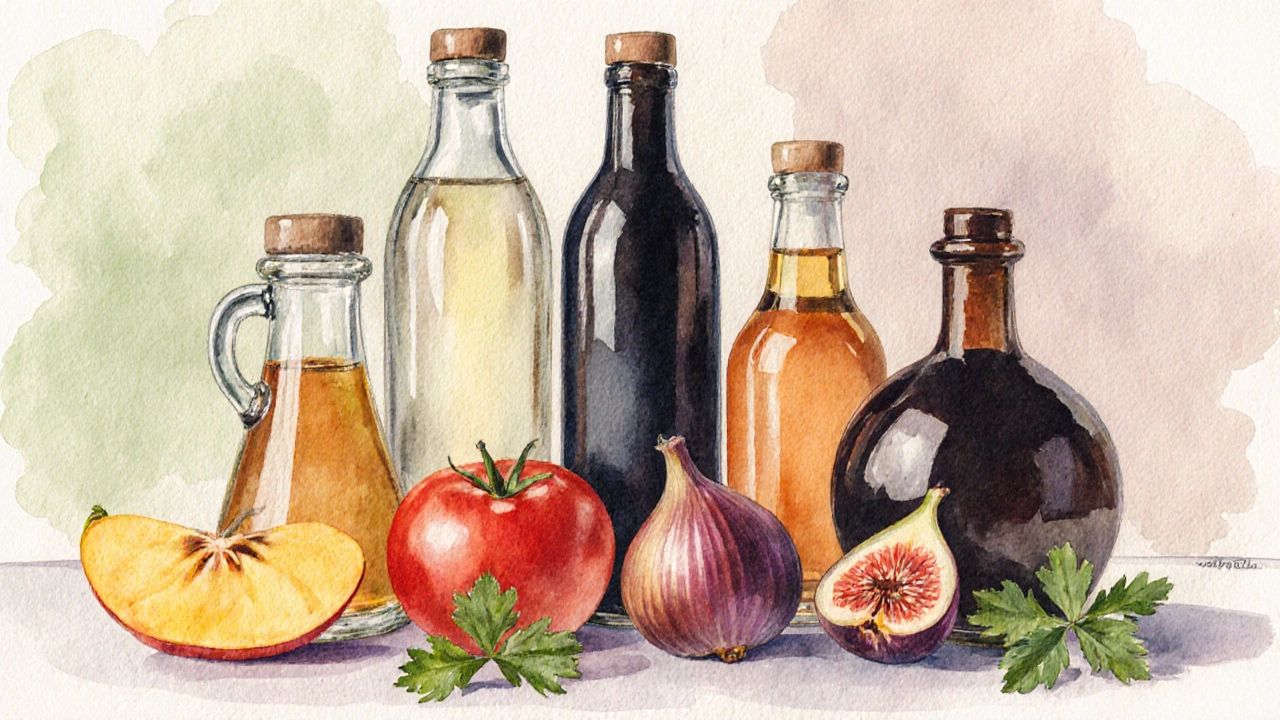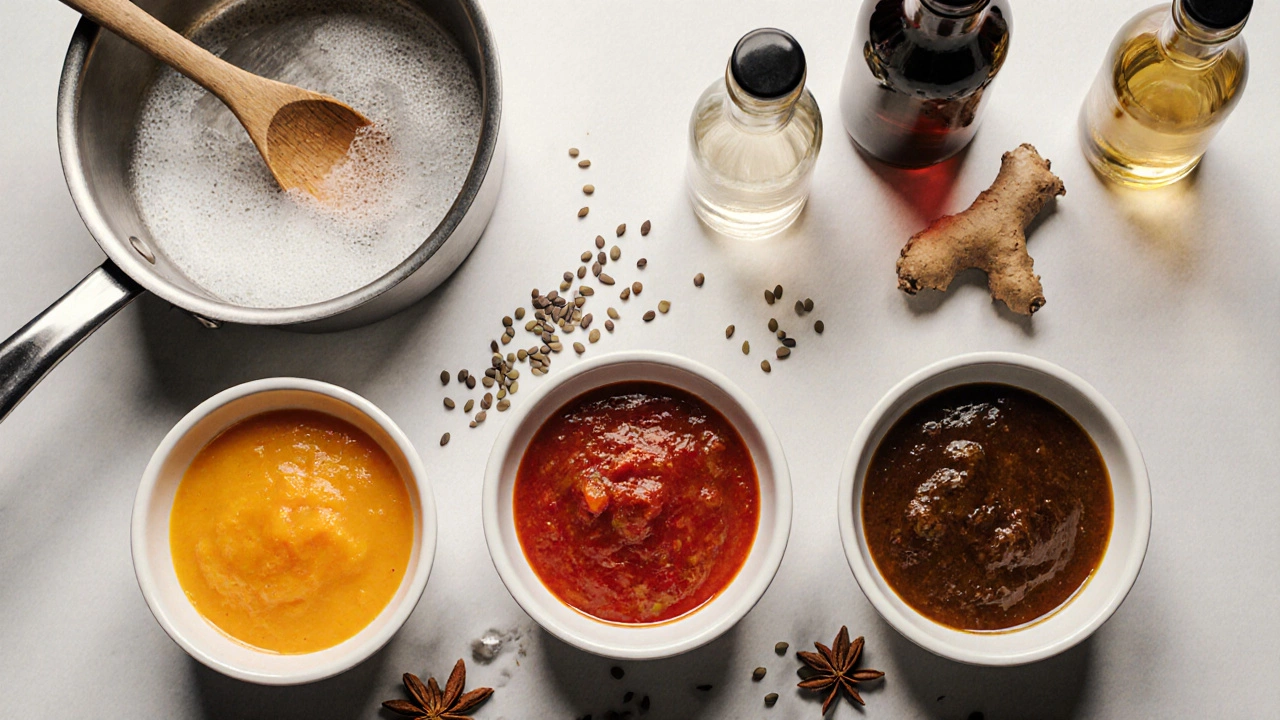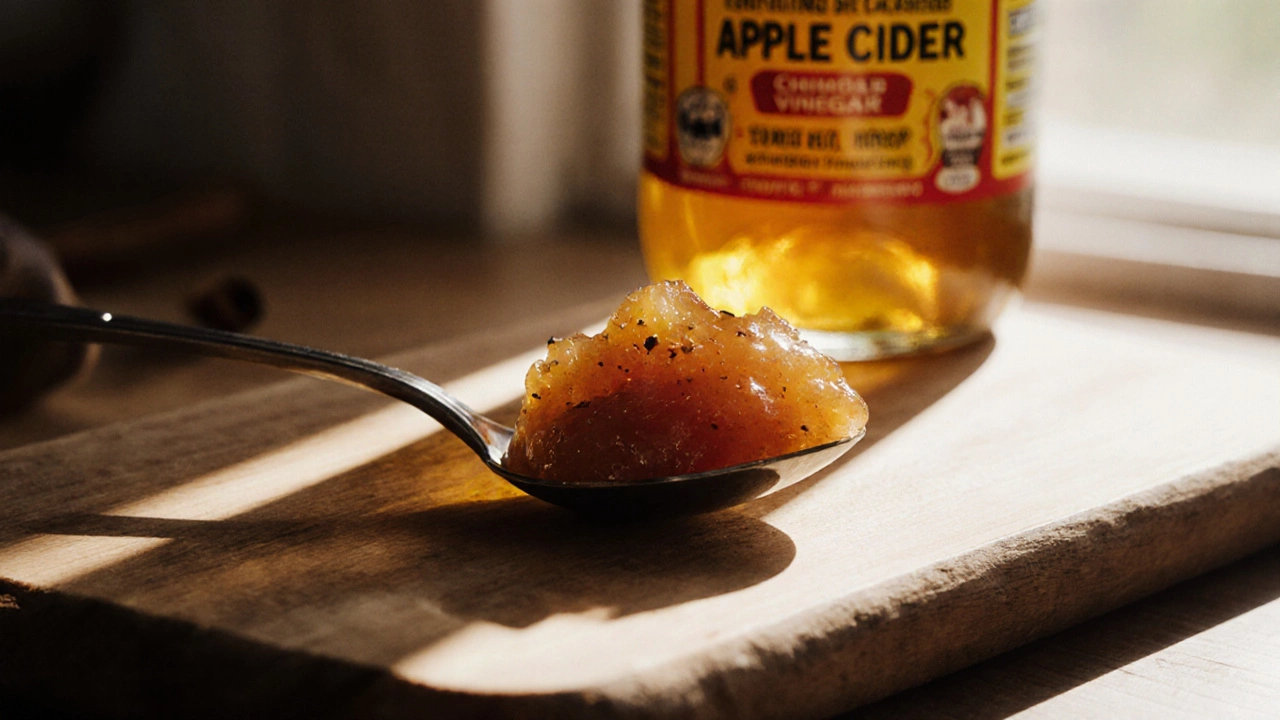14 Oct 2025
- 0 Comments
When a spoonful of chutney hits the palate, the zing you feel is often thanks to the vinegar tucked into the mix. Picking the right vinegar can turn a bland condiment into a flavor star, while the wrong choice can make it taste flat or overly sharp. Below you’ll find a down‑to‑earth guide that tells you exactly which vinegar works best for different chutney styles, how to balance flavors, and a quick cheat‑sheet you can print and keep in your kitchen.
What is vinegar is a fermented liquid made by converting alcohol into acetic acid?
In simple terms, vinegar is the acidic by‑product of a two‑step fermentation. First, sugars or starches turn into alcohol; then, specialized bacteria transform that alcohol into acetic acid, usually ranging from 4% to 8% in volume. The acid not only preserves foods but also adds a bright, sour bite that balances sweet, spicy, and salty notes.
Why vinegar matters in chutney
Chutney is a balancing act. You’re mixing fruit or veg, sugar, spice, and a splash of acid. Vinegar does three heavy‑lifting jobs:
- Preservation: The acid slows down bacterial growth, extending shelf life.
- Flavor contrast: It cuts through sweetness and rounds off heat from chilies.
- Texture aid: A little acidity helps break down fibrous ingredients, giving a smoother mouthfeel.
If the vinegar is too harsh, the chutney will taste metallic; if it’s too mild, the end result can feel cloying.
Major vinegar types you’ll meet in Indian cooking
Below is a quick rundown of the most common vinegars you’ll see in Indian kitchens. Each entry is marked up with schema.org microdata so search engines know exactly what we’re talking about.
Apple Cider Vinegar is a vinegar made from fermented apple juice, offering a mild fruitiness and a 5‑6% acidity level. It’s a go‑to for sweet‑spicy mango or pineapple chutneys because its subtle fruit notes complement the base fruit without overwhelming it.
White Wine Vinegar is a vinegar produced from white wine, known for its crisp, slightly alcoholic edge and 6‑7% acidity. Use it in tomato‑based chutneys where you want a clean, sharp lift that lets the tomatoes shine.
Malt Vinegar is a vinegar made from malted barley, delivering a deep, earthy flavor and about 5% acidity. It works well in onion or tamarind chutneys where a robust, anchoring note is desired.
Rice Vinegar is a light‑bodied vinegar fermented from rice, typically with a mild sweetness and 4‑5% acidity. Ideal for green herb chutneys (coriander, mint) where you don’t want the acid to dominate the fresh greens.
Balsamic Vinegar is a dark, syrupy vinegar aged from grape must, featuring a sweet‑tart profile and 6% acidity. A drizzle in a fig or raisin chutney adds depth and a subtle caramel finish.

Flavor guide: matching vinegar to chutney base
Think of vinegar as the supporting actor that makes the lead (fruit, veg, or spice) shine. Here’s a quick cheat‑sheet:
- Mango or pineapple: Apple Cider Vinegar - its fruit undertone echoes the mango’s tropical sweetness.
- Tomato or beetroot: White Wine Vinegar - its clean bite cuts through the earthiness.
- Onion or tamarind: Malt Vinegar - the malt’s depth balances the pungent onion or sour tamarind.
- Fresh herb (coriander, mint): Rice Vinegar - light acidity preserves the bright green flavor.
- Dried fruit (fig, raisin): Balsamic Vinegar - the sweet‑tart notes merge with the fruit’s natural sugars.
How to pick the right vinegar for your chutney - a step‑by‑step checklist
- Identify the primary flavor of your chutney (sweet fruit, tangy veg, earthy spice).
- Consider the desired acidity level. For very sweet chutneys, aim for a milder vinegar (4‑5%). For sharper, spice‑forward chutneys, choose a higher‑acid vinegar (6‑7%).
- Match the vinegar’s flavor profile to the main ingredient using the cheat‑sheet above.
- Do a small taste test: mix 1tsp of vinegar with a spoonful of the cooked base, add a pinch of sugar, and taste. Adjust up or down in ½tsp increments.
- Remember that heat mellows acidity. If you’ll cook the chutney for a long time, you can lean toward a slightly stronger vinegar.
Three simple chutney recipes that showcase the right vinegar
1. Apple‑Mango Chutney (Apple Cider Vinegar)
- 2cups diced mango
- ½cup brown sugar
- ¼cup Apple Cider Vinegar
- 1tsp grated ginger
- ½tsp chili flakes
Cook over medium heat, stirring until the mixture thickens (about 15minutes). The apple cider vinegar adds a gentle fruity acidity that blends perfectly with the mango.
2. Tomato‑Onion Chutney (White Wine Vinegar)
- 3cups chopped tomatoes
- 1cup thinly sliced onions
- ¼cup White Wine Vinegar
- 2tbsp mustard seeds
- 1tsp sugar
Saute mustard seeds, then add onions and tomatoes. Simmer for 20minutes, finishing with the vinegar. The crispness of white wine vinegar lifts the tomato's natural umami.
3. Tamarind‑Onion Chutney (Malt Vinegar)
- ½cup tamarind pulp
- 1cup caramelized onions
- ¼cup Malt Vinegar
- 2tbsp jaggery
- ½tsp cumin powder
Blend tamarind with warm water, add to the onions, stir in malt vinegar, and simmer 10minutes. The malt’s earthiness balances the sour tamarind beautifully.

Comparison table: quick look at the top five vinegars for chutney
| Vinegar | Acidity % | Flavor notes | Best chutney base | Typical use |
|---|---|---|---|---|
| Apple Cider Vinegar | 5‑6 | Light fruity, mild | Mango, pineapple, peach | Sweet‑spicy fruit chutneys |
| White Wine Vinegar | 6‑7 | Crisp, clean, slightly alcoholic | Tomato, beetroot, cucumber | Vinegary tang for veggie chutneys |
| Malt Vinegar | 5 | Deep, earthy, malty | Onion, tamarind, lentil | Robust, grounding acidity |
| Rice Vinegar | 4‑5 | Delicate, slightly sweet | Herb (coriander, mint), green chilli | Light‑handed lift for fresh chutneys |
| Balsamic Vinegar | 6 | Sweet‑tart, syrupy | Fig, raisin, date | Rich, dessert‑style chutneys |
Common pitfalls and pro tips
Pitfall #1 - Over‑acidifying: Adding too much vinegar at once can mask other flavors. Always start with a teaspoon and build up.
Pitfall #2 - Ignoring the vinegar’s flavor: Not all vinegars are neutral. Pair the underlying notes with the main ingredient, not just the acidity level.
Pro tip - Toast spices before adding vinegar: A quick fry of mustard seeds, cumin, or fennel in oil releases aromatics that marry better with the acid, creating a smoother finish.
Pro tip - Store chutney in the fridge: Even with vinegar, refrigeration keeps texture fresh and prevents spoilage, especially for fruit‑heavy batches.
Frequently Asked Questions
Can I substitute lemon juice for vinegar in chutney?
Yes, but lemon juice brings a brighter, citrusy tang and lower acidity (around 5%). It works well in herb chutneys but may lack the preserving power of vinegar for longer‑shelf‑life recipes.
Is aged balsamic vinegar too sweet for most Indian chutneys?
Aged balsamic can be sweet, but a small drizzle (½tsp) adds depth without overwhelming the chutney. For very sweet fruit bases, choose a younger balsamic or balance with a bit more chili.
How long can I keep vinegar‑based chutney at room temperature?
If the chutney contains at least 5% acidity and is sealed in a sterilized jar, it can sit at room temperature for up to two weeks. After that, move it to the refrigerator to stay fresh.
What’s the difference between rice vinegar and apple cider vinegar in flavor?
Rice vinegar is milder and slightly sweet, making it ideal for delicate green chutneys. Apple cider vinegar carries a gentle fruitiness that pairs with sweet fruit bases, adding subtle complexity.
Should I add vinegar before or after cooking the chutney?
Add it near the end of cooking (last 5minutes). This preserves its bright acidity while still letting it meld with the other flavors.
